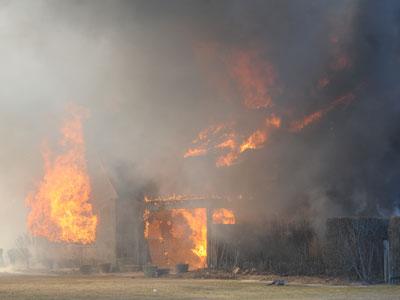Hard Rock Café Co-Founder's House Destroyed by Fire

A historic oceanfront house at 57 West End Road was destroyed Wednesday by a massive fire despite the efforts of seven fire departments and about 100 firefighters.
East Hampton Fire Department Chief Richard Osterberg Jr. described it Thursday as a total loss. The wind, he said, was a major factor in the disaster, fanning the already out-of-control flames by the time firefighters reached the scene.
The initial effort was hampered by the lack of access to a proper fire hydrant.
The 911 call came in at about 2:35 in the afternoon, the chief said. Firefighters remained on the scene for almost seven hours, not leaving until about 9:30.
Gerry Turza, a second assistant chief, was one of the first on the scene. Within minutes, it became clear that it would not be possible to send firefighters into the structure, Chief Osterberg said. "We had a well-advanced fire." Instead, they had to combat the blaze from the outside, pouring on as much water as they could.
Water quickly became an issue. The closest hydrant they could find was fed from a narrow water main. "The hydrant on West End didn't supply enough water for one truck," Chief Osterberg said.
When firefighters did find a fire hydrant they could use, it was on Apaquogue Road, about 3,000 feet away, the equivalent of 10 football fields. Using hoses from the East Hampton and Southampton departments, the firefighters finally had a second source of water, besides the tankers, to combat the blaze.
In the meantime, the various tankers from the different departments, all about 3,000 gallons in capacity, would take turns pumping their water into a dump tank set up at Lily Pond Lane and Apaquogue Road, which in turn would feed a supply engine truck, and from there the other engines.
The mission quickly turned to saving the other houses in the area.
Multiple tankers and engine trucks were called in from across the South Fork. "It was the ultimate team effort," the chief said. Montauk sent an engine and a tanker, Southampton two tankers, a tanker and an engine were sent from North Sea, and the same from Amagansett.
Sag Harbor sent a rapid intervention team to the scene. These teams are trained to extract firefighters from burning interiors when needed. Since no firefighters would be sent into the house, the Sag Harbor unit was deployed on an engine.
Initially, the North Sea firefighters were held in reserve at the East Hampton Fire Department headquarters on Cedar Street in case any other emergencies arose. That is exactly what happened when a plane skidded off a runway at East Hampton Airport. Though there did not appear to be fuel leaking from the plane, the North Sea department was sent to the airport, with Hampton Bays then sending a crew to East Hampton as additional backup, the chief explained.
The initial attack on the fire was from an East Hampton tanker. If the wind had not been blowing so hard, Chief Osterberg said, they might well have extinguished the blaze, he said.
Once the fire was extinguished, well after dark, its debris was excavated, in the search for burning embers. The department had to return twice, including once Thursday morning, when small fires popped up in the ruins.
One firefighter suffered a minor injury when he was struck by a piece of equipment, the chief said, and was taken to Southampton Hospital as a precautionary measure.
Though Ken Collum, the East Hampton Village fire marshal, was not available Thursday because he was attending a state-mandated class, he had arrived at the West End Road fire about halfway through the operation Wednesday, and conducted a thorough investigation, East Hampton Village Police Chief Gerard Larsen said Thursday.
Chief Larsen had conferred with him, in case there was any need for criminal charges to be brought. It was Mr. Collum's assessment, Chief Larsen said, "that he did not feel there was any reckless or criminal behavior involved" in the start of the fire. According to Chief Larsen, torches being used by workers on the roof ignited the wood underneath, with the wind taking over.
According to Richard Barons of the East Hampton Historical Society, the house was built in 1926 for Ellery S. James, and was designed by Roger Bullard, who also designed the 1922 Maidstone Club clubhouse. It was featured in the Architectural Record in 1933. A 1920s-era real estate booklet from the Strong Brothers described the house as having a large first-floor living room, a library with a bathroom, a dining room, butler's pantry, kitchen, laundry, maid's dining room, two large supply closets, Ping-Pong room, and two double guestrooms with baths. Upstairs was equally as lavish, with five master bedrooms, four maids rooms, and baths. Several more maids and butlers bedrooms were in the garage, along with room for five cars. The rent was $4,500 for the season.
The 1.3-acre property is owned by West End Road Partners of Los Angeles. Peter Morton, co-founder of the Hard Rock Cafe restaurant chain, was listed as the applicant in an East Hampton Village Zoning Board of Appeals hearing in February on placement of air-conditioner units at the property.
Chief Osterberg lauded the work of all the departments involved, as well as the East Hampton Village Ambulance Association, and the village police, who were instrumental in keeping the extremely narrow, almost one-lane West End Road open for trucks to move in and out.
